New York, NY! It's a wonderful town! It's the city so nice they named it twice. Not only that, it's the city that we're talking about next for our America's Iconic Signage blog entry. Being a city that is an icon in and of itself, there were tons of signs we could have picked to showcase. In addition to the architecture and skyline, signs are the tangible elements that embody the heart and feeling of a city. We take pictures in front of signs to prove that we've been there and to create a memory that identifies the place and time where we were. Here are a few signs that have become as iconic as The Statue of Liberty.
1. Rainbow Room Observation Deck and NBC Studios
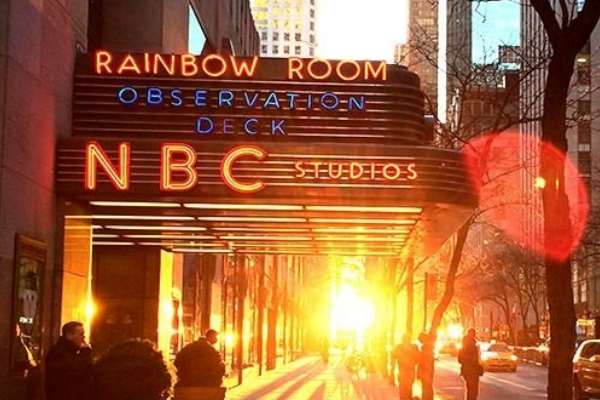
This may not have a lot of importance to everybody, but it's certainly iconic to pop culture buffs and TV lovers. This sign juts out from the historic GE building located at 30 Rockefeller Center. The Rainbow Room Restaurant was opened in 1934 by the Rockefeller family who owned the building. It was a place for fine dining, intimate concerts, and hobnobbing with Manhattan's finest. The Rockefellers passed the operations of the Rainbow Room over to the Cipriani family in 1998. After a major overhaul of staff, some rumors about entanglements with the Gambino mob family, and one request for historical landmark status, the kitchen closed its doors in 2009. The doors are still currently closed but it has been going through a remodel since 2011 with hopes of opening in 2014. More famous than the restaurant is the television studio that has housed such beloved pieces of American popular culture like The Tonight Show with Johnny Carson (now hosted by Jimmy Fallon), Saturday Night Live, and the NBC Nightly News.
2. Tom's Restaurant
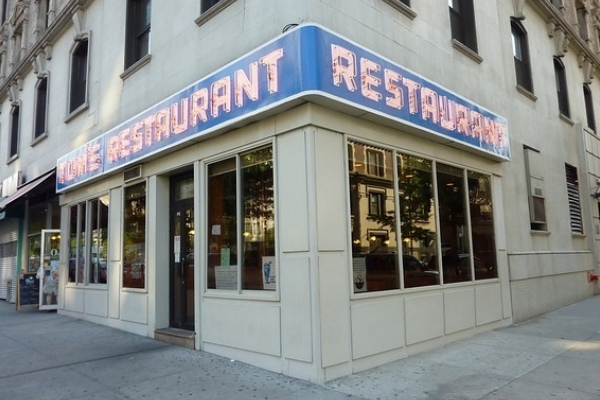
Here's another one for the TV buffs. Tom's Restaurant in Manhattan is probably better known as "Monk's Café" from the TV show Seinfeld. The site of many of the show's sketches like "The Big Salad" or Jerry finding out that he and his female doppelganger both order cereal at restaurants (incidentally you actually can order a bowl of cereal at Tom's for $3.25). The Greek-American restaurant was also immortalized in Suzanne Vega's dreamy 1990 hit "Tom's Diner." Since its opening, Tom's has also been a meeting place and hub for hungry Columbia students looking for a place to eat and study at 3:00 a.m.
3. Times Square Digital Signage
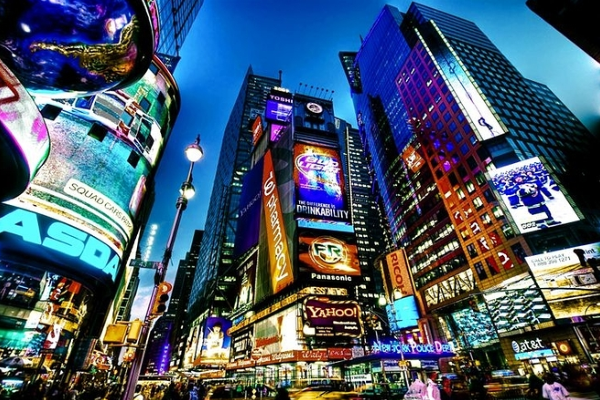 It's one of the biggest tourist attractions to New York City, but it wasn't always that way. The city block got the name of "Times Square" when, in 1904, the editor of the New York Times (Adolph S. Ochs) moved the operations of the newspaper to a building on 42nd street and convinced Mayor George B. Mclellan to put a subway stop near their building. The first electric advertising sign was also installed in 1904. From the early 1900's to around 1930, Times Square was primo real estate and hosted Broadway and Vaudeville stars such as Fred Astaire and Charlie Chaplin. But, after the stock market crashed and the Great Depression took over the country, Times Square fell into ruin and was a seedy and crime-ridden place from the 1930s to about 1990. In 1990 the State of New York took over Times Square and restored many of the historic theaters on 42nd Street and Broadway and brought life back into the square. Now the towers of gleaming LED and neon lighted signs are instantly indicative of the City itself. You've seen the signs in countless superhero and monster movies flickering and being smashed, you've looked at people jumping around the windows of Good Morning America trying to get on TV, and (if you've actually been) you've probably seen all manner of insanity from the Naked Cowboy to the dropping of the ball on New Year's Eve. After a long rough history, this theatrical mecca has risen like a phoenix from the ashes to something spangled and spectacular.
It's one of the biggest tourist attractions to New York City, but it wasn't always that way. The city block got the name of "Times Square" when, in 1904, the editor of the New York Times (Adolph S. Ochs) moved the operations of the newspaper to a building on 42nd street and convinced Mayor George B. Mclellan to put a subway stop near their building. The first electric advertising sign was also installed in 1904. From the early 1900's to around 1930, Times Square was primo real estate and hosted Broadway and Vaudeville stars such as Fred Astaire and Charlie Chaplin. But, after the stock market crashed and the Great Depression took over the country, Times Square fell into ruin and was a seedy and crime-ridden place from the 1930s to about 1990. In 1990 the State of New York took over Times Square and restored many of the historic theaters on 42nd Street and Broadway and brought life back into the square. Now the towers of gleaming LED and neon lighted signs are instantly indicative of the City itself. You've seen the signs in countless superhero and monster movies flickering and being smashed, you've looked at people jumping around the windows of Good Morning America trying to get on TV, and (if you've actually been) you've probably seen all manner of insanity from the Naked Cowboy to the dropping of the ball on New Year's Eve. After a long rough history, this theatrical mecca has risen like a phoenix from the ashes to something spangled and spectacular.
4. The Subway Signage
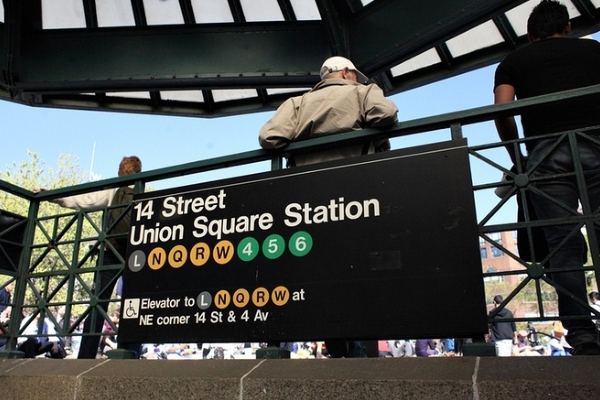
One very iconic type of signage is integrated with the city as a whole: the subway signs. In the beginning of the NYC subway there was little to no standardization of the subway's signage. There were tiled signs from the '30s, painted signs, and hanging signs. In the late '60s and into the '70s the city decided to take on an ambitious brand identity project with the city signage—especially the subway signs. Massimo Vignelli and Bob Noorda were the designers hired for the job. They created a standards manual that, aside from some updating and tweaking, has lasted until today. The standards manual called for black text on a white background but this has been reversed to help prevent graffiti. The text was also (famously) updated to the ever popular and readable font Helvetica. In a city as diverse, sprawling, and interconnected as New York City, it was virtually impossible for the new brand standard to completely take over overnight. But, despite the fact that you can still find older versions like the art-deco tiled signs, the 1970s overhaul is pretty much status quo today and will probably remain so for a long time.
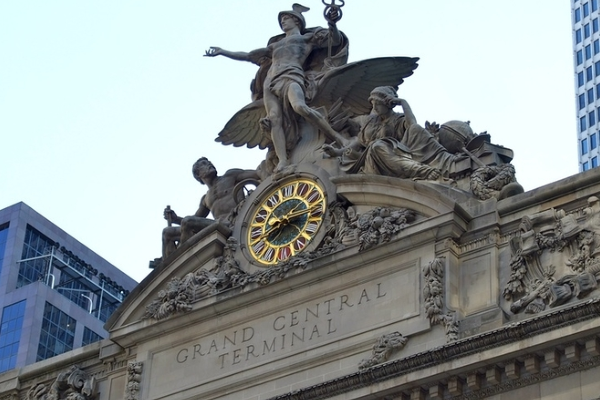
There's nothing like a sign flanked by romanesque statues, am I right? Formerly the site of the Grand Central Depot in the late 1800s, the illustrious Vanderbilt family decided to commission an updated Grand Central Terminal in the early 1900s to update and change with advances in railway technology. In 1903 the railway created a design competition between different architectural firms to see who would get to create the new station. The winners were Reed & Stem for their innovative ramp designs, but the railroad also hired Warren & Wetmore to create the monumental arches and facade of the building. The architects brought in French artist Sylvain Saliéres to help create the ornate bronze and stone carvings outside the building, the chandeliers inside the terminal, and the ornamental inscriptions. The statues around the exterior sign are of Minerva, Hercules, and Mercury who are symbols of wisdom, strength, cleverness, and speed—exactly the qualities the Vanderbilts wanted people to associate with their railway. There are also sculpted oak leaves and acorns which (as we know from Vanderbilt University here in Nashville) are symbols of the Vanderbilt family.
6. Tiffany & Co.
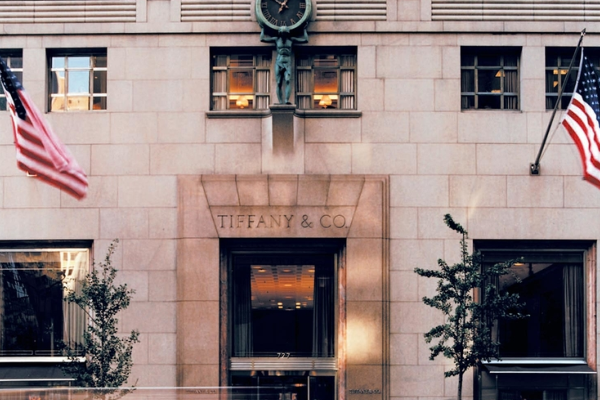
Is that the lilting refrain of "Moon River" I hear? The facade of the world famous jewelry and luxury goods company's flagship store on 5th Avenue is made even more famous by the adventures of Truman Capote's Holly Golightly in the 1961 film, Breakfast at Tiffany's. The renowned store opened its doors on October 21, 1940. Visitors are also drawn to the shop because it houses and displays "The Tiffany Diamond"—a 128 karat diamond on display on the main floor. Not to mention, the mezzanine level is home to a collection of historic watches.
Obviously these are a small sampling of signage the city has to offer. Which ones would you add to the list? Leave a comment below!
Looking for your own iconic signage? Give us a call or click the button below for a free quote!



Leave a Reply